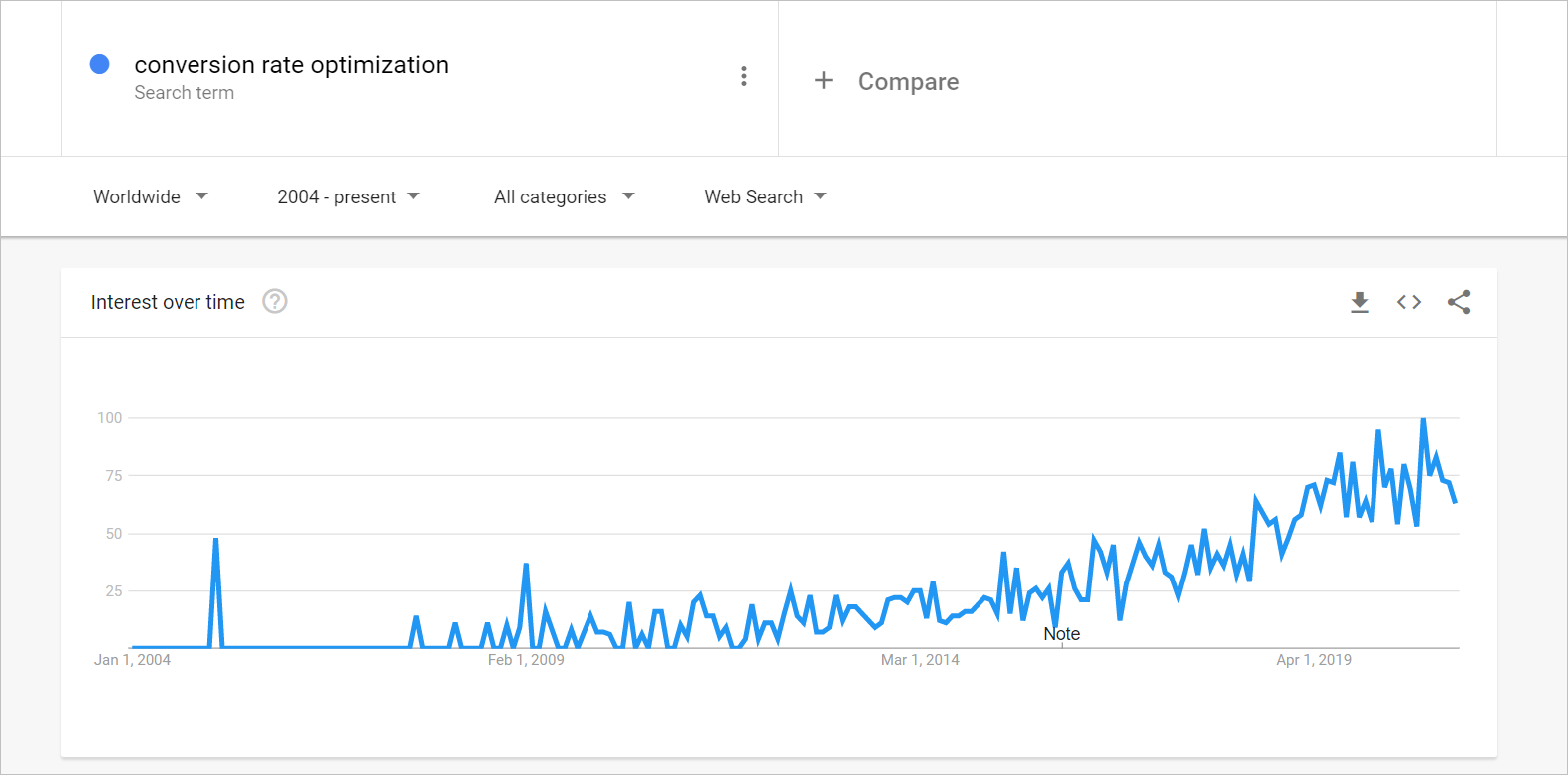Summary: With interest in CRO at an all-time high, it’s crucial for digital marketers to get a wider perspective on the increased importance of conversion rate optimization as the key that can unlock revenue and business growth potential.
What will conversion rate optimization look like in 2021 and beyond? Learn how the industry is poised, and what that means for you.
In this article we are going to cover:
- The Current State of Conversion Rate Optimization
- The Forces Driving Conversion Rate Optimization in 2021
- What Lies Ahead for CRO
- Future-Proof Your Strategy
Conversion rate optimization (CRO) went mainstream about 5 years ago. At least that’s what we like to think. Conversion rate optimization has definitely enjoyed increasing interest, as depicted in the Google Trends graph below:

However, most organizations have barely moved from the awareness and interest stages to actually taking decisive action. In the majority of companies, conversion rate optimization efforts are largely focused on tactics. There’s little attention paid to developing and implementing a conversion strategy for the long haul.
The Current State of Conversion Rate Optimization in 2021
More companies are interested in conversion rate optimization today than 5 years ago.
Sadly, this popularity has not necessarily resulted in CRO getting utmost priority. In fact, last year’s report on the Annual State of Conversion Optimization by CXL and Convert shows that …
- … conversion optimizers continue to experience friction from higher-ups.
- … companies may hire someone for testing but often have unrealistic expectations about what they should gain from tests.
It seems higher-ups often expect immediate ROI in the form of winning tests and immediate conversion lifts. Ironically, digital marketers and conversion optimizers are expected to deliver value but enjoy little support when it comes to resources for tools or skill upgrades.
CRO Still Not a Priority
This situation points to the highly uneven development across companies and industries when it comes to conversion optimization practice. Here, the CRO elites – which include some of the world’s biggest brands (e.g. Amazon and Google) – are already in the advanced optimization stage in the CRO maturity model. The vast majority of e-commerce and business-to-business (B2B) websites, on the other hand, are either left in the unoptimized stage or have only recently begun basic optimization.
The findings from Decibel and Econsultancy’s report on The State of Digital Experience and Conversion in 2020 affirm this gap:
- Out of 300+ company respondents, only two-fifths had adopted a strategic approach based on a deep understanding of their customers’ paths to purchase.
- Most companies continue to apply a purely reactive approach to solving their digital experience problems, focusing on short-term, tactical optimization.
By now, the few advanced companies have optimization deeply embedded into their culture. They’ve had quite a head start. They’ve moved on to integrating conversion rate optimization strategies and tactics into different parts of their business. They’re optimizing not just their websites but the entire customer experience. Their CRO strategy extends to product lifecycle development.
Companies who are still at the early stages of the CRO ladder would need to think strategically if they want to catch up. If you are interested in having an in-depth audit of your website, you can learn more about our website audits at this link: Conversion Audits
Subscribe to the SiteTuners Weekly Email
Grow Your Business
Exponentially with Proven
Conversion Rate
Optimization Expertise.
The Forces Driving Conversion Rate Optimization in 2021
We have good reason to believe that more companies will be compelled to change their approach to conversion rate optimization in 2021. The confluence of major external forces, events, and trends will significantly affect optimization decision-making processes and practices.
COVID-19 Pandemic
The COVID-19 pandemic had a massive impact on businesses. It created both opportunities and challenges for business owners. As worldwide lockdowns were imposed, customers migrated to digital channels and marketplaces. This fast-tracked the looming decline of purely brick-and-mortar stores which relied on foot traffic. At the same time, it created a boom in e-commerce and forced many companies to finally make the overdue jump to digital.
And there’s no going back.
The results of COVID-19 and E-commerce survey done by UNCTAD and Netcomm Suisse E-commerce Association show that the pandemic engendered long-lasting, deeper changes in customer shopping habits and behaviors. People have become reliant on the internet not just for online shopping but for more of their daily needs. This includes news consumption and entertainment. In a sense, the digital shift hasn’t only been for e-commerce – it goes deep into the core of people’s lives.
There are unique challenges to the digital boom. At the beginning of the pandemic, retailers had to contend with logistical nightmares. Steep increases in demand led to supply shortages. Major e-commerce players such as Amazon had to intervene in the marketplace to prevent price gouging on health and sanitation items. Companies have to learn their lessons and adapt quickly in order to succeed in the new normal.
Technological Advancement
Technology and innovation are behind the biggest trends in digital marketing for 2021. Artificial intelligence (AI), marketing automation, and the continued proliferation of free and low-cost optimization tools are rapidly changing the business landscape.
Artificial Intelligence
AI and machine learning have the potential to transform conversion rate optimization as it is currently practiced. We’re already witnessing the power of AI in amplifying and supporting digital marketing activities such as:
- Chatbots handling routine customer queries
- Algorithms that optimize paid ad campaigns
- AI-powered software for big data processing and analysis
It won’t be long before we see AI getting deployed for more complex applications such as biometrics (e.g. facial expression or eye tracking analysis) on websites and other digital channels.
Marketing Automation
With the shift to digital, companies can no longer afford to neglect marketing and business process automation. Automating repetitive and routine tasks helps companies save time and resources. It also streamlines marketing processes, increasing your efficiency at acquiring and retaining customers.
Marketing automation might be common for top-tier companies and startups, but is either unheard of or improperly implemented at unoptimized businesses.
Cheap Optimization Tools
The number of free or low-cost conversion and website optimization tools has exploded. This has lowered the barrier to entry for conversion rate optimization. Today, anyone with a website who has access to tools like Google Optimize can easily begin split tests.
There’s an upside and a downside to the widespread availability of CRO tools. On the one hand, it encourages companies to start optimizing their sites and channels. On the other hand, it can also invite unrealistic expectations from new optimizers who often do a deep dive with little knowledge of the traffic and statistical requirements for successful experimentation. The Annual State of Conversion Optimization by CXL and Convert point out that a growing majority of optimizers only had at most 3 years of experience in the field.
(Read When Not to Test: 5 Conditions that Make Website Testing a Bad Idea)
Regulatory environment
State oversight has become more significant as online users grow increasingly concerned with how companies use (or misuse) their personal data. In the last few years, concerns surrounding data privacy have also mounted as a result of data breaches. Data from Statista shows that 53% of global internet users were more concerned about online privacy in 2019 than they were a previous year ago.
GDPR and CCPA
Conversion optimizers and digital marketers, in general, should be aware of the ramifications of government policies such as the General Data Protection Regulation (GDPR) enforced by the European Union in 2018 and the similar California Consumer Privacy Act (CCPA) that took effect in January 2020. These policies regulate data collection and processing, activities that are crucial to understanding visitor usage patterns, interaction, and behaviors on a website or any online channel.
GDPR and similar laws underscore the importance of user consent, necessity, and transparency in digital marketing practices. These regulations will undoubtedly compel marketers to move towards better data and privacy protection of their online users. Marketers are still allowed to collect data but only those that are absolutely necessary for the transaction to happen. GDPR compliance also means digital marketers can’t hoard or store data especially if it’s not being used for user and customer experience improvements.
Big Tech Companies
Aside from the state, big tech actors also play a significant role in shaping digital marketing and conversion rate optimization in 2021. Big tech like Google, Facebook, Amazon, and Apple may not have the ability to lay down policies and laws, but they’re highly influential in setting the bar for usability, user experience, and personalization.
What Lies Ahead for Conversion Rate Optimization
Digital marketing and conversion rate optimization have always operated in a fast-paced, dynamic landscape. However, COVID-19 and the technological and regulatory developments have brought unprecedented changes in the competitive landscape and ultimately drives the following:
Strategic Conversion Rate Optimization
Businesses will need to shift to a longer-term perspective in their digital marketing and conversion rate optimization efforts in order to gain a sustainable competitive advantage. This means optimizing the entire business as opposed to tactical responses to issues that arise. Tactical optimization is useful but it can only do so much.
It’s necessary for companies to start investing in more strategic aspects such as improving processes and building a truly data-driven culture to increase their digital marketing efficiency and effectiveness. Companies also need to focus on marketing automation and customer journey improvements to cope with increasingly higher user expectations.
AI-powered CRO
Artificial intelligence is only getting better at contextual awareness. There’s little doubt that it will transform conversion rate optimization as we know it. It will allow us to achieve a better understanding of online users and increase our ability to predict digital behavior.
The combination of AI and automation will vastly enhance our capabilities at delivering accurate, relevant content and targeted messages to online users at a scale. To achieve this, businesses must be able to incorporate AI and machine learning when planning their conversion rate optimization strategy.
Secure, Humanized Experiences
User experience (UX) is one of the pillars of conversion rate optimization. The crux of CRO is to improve website user experience so online visitors are comfortable enough to move along their journey with you.
The growing demand for privacy and security among online users is but a reminder that online privacy and security are important psychological needs that must be addressed. Digital marketers and conversion optimizers must strike a balance between their data needs and online visitors’ data privacy rights. This not only means actively seeking consent from online users or disclosing how data is used, but actually investing in improving data management and governance to prevent security breaches and secure sensitive customer data.
If you are interested in having an in-depth audit of your website, you can learn more about our website audits at this link: Conversion Audits
Conversion Rate Optimization in 2021: Future-Proof Your Strategy
With everyone moving to digital, having an optimized online experience can spell the difference between success and failure for your business.
Companies in the advanced CRO levels are already tinkering with AI, personalization, and other sophisticated optimization tools. If you’re still in the unoptimized stage or are only now dipping your toes into CRO, it’s time to step up your game. A reactive, tactical approach to optimization is bound to get you only short-term wins. You have to start thinking about conversion rate optimization strategically if you want to take your business to another level. Do you need help in knowing where to start? We can perform one of our website audits where you will get a detailed tactical and strategic roadmap to improve your conversion rate optimization in 2021. To learn more about our website audits, visit this link: Conversion Audits
The future isn’t set in stone, but your business’s future is entirely in your hands.

